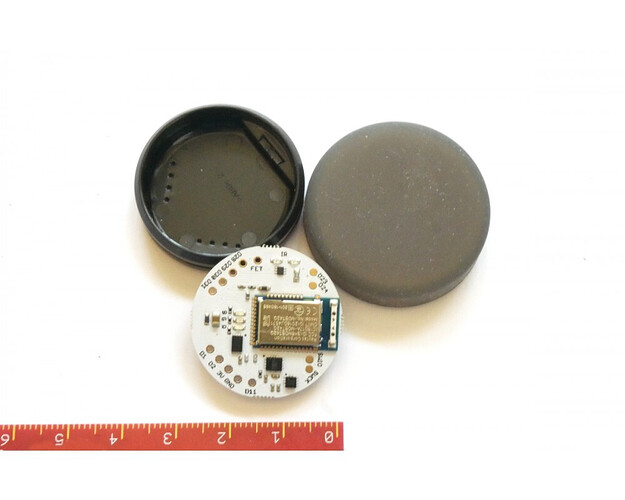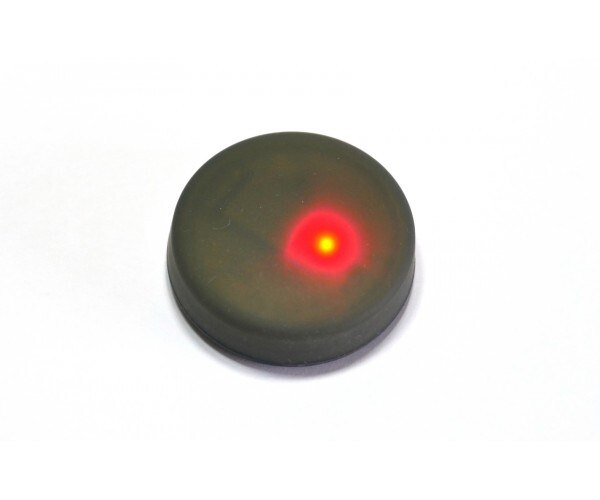I recently saw an ad for the Espruino Puck.js v2 and I noticed it’s marketed as a small, low power, bluetooth programmable smart button with RGB leds, a tactile button, built in NFC, tons of onboard sensors and solderable GPIO’s. The board is circular and smaller than the flexNExt in diameter but it’s thicker due to the battery mount. Obviously the battery mount would need to be unsoldered and replaced by an induction coil to be powered by a wearable battery pack (unless anyone has any ideas on how to harvest enough power to run a microcontroller). I recently discovered Biohacking and I was mostly was just curious if anyone else thought that it may be doable before I bought one and started modding it or if anyone else has similar ideas about it?
Just thought I would share the link, and allow the hive mind to check it out
Even has a blinkie for those LED Junkies
I’d defo love it as wearable.
CR2032… ![]()
@Atilla I thought it would be a cool implant in conjunction with a raspberry pi zeroW based smartwatch/battery pack to wear over the coil for powering it and holding all of your programs so you can change them on the fly and use it as a display for the puck. A couple of lithium ions stepped down to the correct voltage should power them for a pretty good amount of time. (Also if anything I am saying sounds like it wouldn’t work, or if there’s a better way to do something, criticism is very appreciated haha)
I’m easy to be convinced.
I’m wondering what I would do with a programmable computer under my skin at the moment.
Others will argue about the power source. I leave it for them…
Now I think… ![]()
This would be a great candidate for a trans dermal powering.
1 extend the battery leads with a bit of 30g to a 2032 holder
2 stick that sucker, sans battery, in you somewhere showoffy (battery out ofc)
3 add a magnet to hold the 2032 holder (sub-dermal but optional I guess)
4 ???
5 profit?
Sounds hacky, but we are here to be cyborgs and hack the planet, so why not be able to play retro games from your neck?
Ohh, Almost forgot: @Cjlbeard Hello and welcome!

As I said: I’m not the fan of a CR2032 under my skin. Also bit concerned about the longevity of moving parts.
But for the sake of a thought experiment I’ll ignore these and treat the computer as it was wearable:
I could use it as an assistant in the studio: turning house lights on and off.
I could measure exposure time with it.
I could release the camera shutter with it.
I could trigger the flash when measuring light.
I could monitor my body temp…
Noo, I need an array of this stuff on a belt or something. Cool little device! ![]()
@LordSethos2000 I would be a little concerned about snagging the battery mount on anything, and the entire assembly needs to be biosafe so I’m not sure if there would be a good “stopping point” for your bioproofing of the implant, considering the battery needs good contact on the outside. I’m definitely going to do some more research about your idea though, as I want it to be as sustainable as possible and replacing disposable batteries is a lot easier and cheaper than maintaining Li Ions imo.
@Atilla Thanks for the welcome! I’ve been lurking in the forums for a few months now, and I’m excited to start working on projects. I’m not super stoked about the idea of having a battery implanted either, and wireless wouldn’t be ideal because having to wear something in order for your implant to work kind of defeats the purpose in my mind. However, on your point of what you would wanna do with it, I thought that it would be a good starting point for monitoring vitals and alerting you to changes in them via a smartwatch that is also used for controlling the implant. My dream is to design a cheapish and easily accessible implant to help people monitor their own health (original, I know) to cut down on medical expenses and hospital traffic. The onboard temperature, gyro, and accelerometer would be useful for temp, exercise, and sleep patterns, and the benefit of GPIO is that peripheral sensors could be added based on specific conditions and as new technology comes out, we don’t have to start from scratch. I’m still working on compiling a list of what sensors I want to attempt to include in for my first design and I’ll post that when I can talk to some medical students at my college to see what they think is most important to monitor.
Nah, I’d call it ambitious.
I’d start with the power source. Once that’s sorted there is a new dimension opening up at once.
Hey Cjlbeard, welcome to the forum!
This all sounds like a solid plan. I think your inclination to do wireless charging is good. Implanted batteries suck because they produce gas, nobody has figured out reliable transdermals yet, all the energy harvesting techniques I’ve seen and tried only produce uW of power, and nobody can get their hands on appropriate nuclear batteries.
I would say it’s pretty bulky (especially the z-height) and you would be better served by making a custom PCB (possibly a flex PCB), but the idea is sound and it’s your body.
One thing I don’t have enough data on is the performance of Bluetooth and WiFi inside the skin. The dielectric properties of flesh (mostly water) mean that some of the signal will be lost as heat as it passes through (moving the water molecules with the signal). Chimpo McDoodle is doing another project with a WiFi connected data storage implant. He’s mostly on the Discord if you want to chat.
Since this board is already set up to be powered from a battery, if you get one could you do a test for all of us? Connect to the device over Bluetooth or WiFi, then put it in a plastic bag while powered on and place it in a bowl of water at various depths to see if it still works and how much the range is reduced? It should be exponential losses.
You’re my hero. I’ve been looking for an implantable health monitor for ages. For my workouts at work.
Bluetooth and wireless ethernet transmission stops kind of direct. You have to use some Sub-GHz module if you want to get anywhere with it. The lower the frequency the better, but the downside is that the antenna size increases with the wave length.
Two questions are left:
- Why would you not transmit all information at the same time and way as your power?
- Why would you implant a device which you have to power from the outside?
That experiment sounds like a fantastic idea! I’ll do some tests next week when I can order one and record the results. I also found a very easy to read research paper about mimicking the properties of skin for experiments, so we may be able to get more accurate results than just plain water. I do know that the PegLegs connect with WiFi and I’ve seen videos of people connecting to them from across the room no problem. I have a feeling that BT is another story, though. Love the challenge!
srt.12235.pdf (291.5 KB)
Well, the first and last picture are more like machines with human parts. For the picture of Ronald McDonald, I don’t even know where to start with that.
All those don’t count as implant in my book.
This ones easy enough. Because of the slow nature of inductors, data transfer over inductive chargers and NFC “antennas” is inherently slow (maybe 400kbps). WiFi and Bluetooth enable much faster data rates.
This one I can’t really answer appropriately, because I agree that it’s kinda silly. It’s a matter of personal opinion though. I will spend my efforts searching for alternative power sources that are safe for implantation, but some are not willing to wait and would rather sacrifice convenience in favor of faster results.




